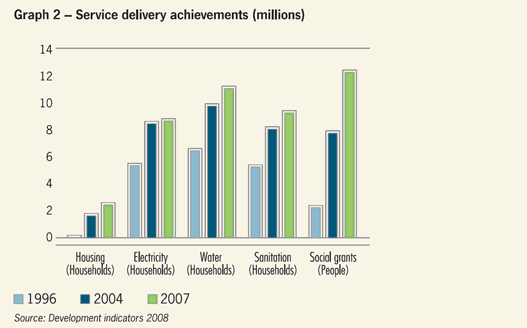
| HOME | OVERVIEW | MEDIA CENTRE | MATERIALS | SOUTH AFRICA TODAY | THE SCENARIOS | REFERENCES | EVENTS |
 |
| Currently viewing: South Africa today / Our Assets / Economic Achievements |
|
OUR ASSETSEconomic Achievements The democratic government inherited a stagnant economy in 1994. Growth had been negative for the previous three years. Under apartheid, our economy was inward-looking, highly concentrated and globally uncompetitive.
In 1994, the country had negative foreign reserves, which by 1999 had ballooned to a negative $25 billion, adding to the total public debt. Debt was nearly 50% of GDP in 995, and the deficit was about 6% of GDP. The situation was aggravated by the absorption of the unknown liabilities of the old bantustan states and covering losses on the Reserve Bank’s forward book. As a result of the uncertainty, the four major international investment ratings agencies would not give the country an investment rating.6 Given this daunting legacy, there have been impressive achievements in macro-economic policy. In the first years of the new government, economic growth became positive, growing by an average of 2.7% between 1995 and 2004, and an average of 5% from 2005 to 2007. This was the longest period of sustained economic growth since the 1940s.7 A contributing factor to the growth of recent years has been government's infrastructure development programme. By the mid 1990s it had become apparent that transport and energy infrastructure was woefully inadequate and that massive spending was needed to avert serious capacity constraints. Other infrastructure such as water and sewerage had also been neglected and required urgent attention. This resulted in significant fixed investment spending, an added boost to the economy. Private sector fixed capital formation also grew, albeit at a more moderate pace, but given that it makes up over 70% of total fixed investment, the effect was even more significant. Growth was also aided when the far-reaching economic reforms of the early years started to yield some of the expected results. Monetary policy achieved more credibility, and inflation expectations had slipped into single digit territory, ensuring a lower level of real interest rates. The budget deficit was steadily reduced until 2007/08 when it became a budgeted surplus. Total debt today is 23% of GDP, and the Reserve Bank has a positive balance of more than $30 billion in foreign reserves. This is an enormous achievement representing a turnaround of more than $55 billion in foreign reserves since 1999.8 As a result, international credit ratings of South Africa have been upgraded, and investment as a percentage of GDP (gross fixed capital formation) has increased from 16% in 1993 to 22% today.
New investment has created more than 3.5 million net new jobs from 1995 to 2008. This has lowered the unemployment rate from about 31% in 2003 to 23% in the official narrow definition by 2008 (and from over 40% to below 36% in the broad definition).9 There have also been some serious interventions to address poverty, most notably the introduction of social grants that are now delivered to about 13 million people.10 In 2009/10, because of the effects of the global economic crisis and lower than expected revenue collections, borrowing has increased and the budget deficit is 3.8% of GDP, but debt costs are still moderate, expected to be 2.5% of GDP over the next three years.
|
VOICES OF DINOKENG
Perspectives from members of the Dinokeng Scenario Team. One of our assets is that we have sound macro-economic policies that properly acknowledge external realities. We’ve got a lot to sort out, but we must acknowledge the good work that’s been done. Our Reserve Bank has done well; it has stuck to its mandate. Our finances are well managed. Public debt has declined and our social wage is bigger and growing. We boast a hard currency and we are a conduit of foreign investment to the rest of Africa.
|

